August 26, 2007
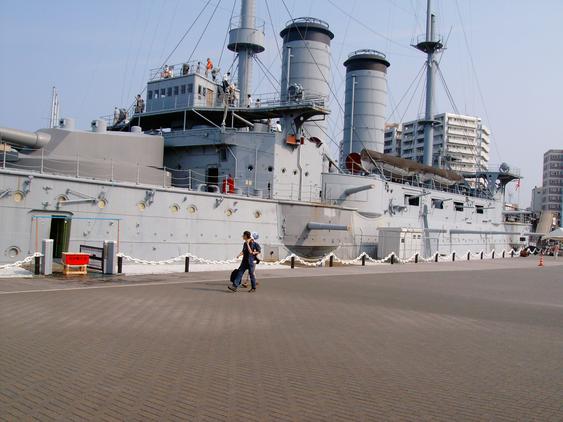
Like virtually all of the Capital ships of the early Japanese Navy she was built in England. The ship was a slightly improved version of the Shikishima and Asahi classes which were themselves very close copies of the excellent Formidable class battleships then being built for the British Royal Navy.
These 4 closely related ships differed from their British counterparts in squeezing in 2 additional 6 inch guns and being built with the smaller stature of the average late 19th century Japanese sailor in mind. In Mikasa there were a few detail improvements over the preceding battleships including her improved boiler arrangement allowing for only 2 funnels but the most important was provision for an admiral and staff and other facilities for the ship to be used as a flagship....
Mikasa was chosen as the flagship of Admiral Togo at the outset of the Russo-Japanese War and was heavily engaged throughout that conflict.
At the Battle of the Yellow Sea, Mikasa took most of the damage and casualties on the Japanese side but it is likely that it was one of her shells that hit the bridge of Tcharvitch, killing Admiral Vitgeft, which ensured the Russian retreat.
The Russian Pacific fleet and the Japanese fleet were fairly evenly matched and both lost 2 battleships during the early part of the war. The Japanese ground forces in Korea were quite successful, but it was realized that they depended utterly upon supply by sea.
The Russians determined to decide the issue by sending their Baltic Fleet (which had the delightfully melodramatic designation of The Great Black Fleet) all the way around the world to reinforce the Pacific squadron and sweep the Japanese from the seas...
The IJN did not sweep easily....
By the time the Russians were in the Indian Ocean they received the dismaying news that their entire Pacific fleet was on the bottom of Port Arthur harbor. Admiral Rozhestvensky decided to make straight for Vladivostock. Togo intercepted him in the Tsushima strait.
Togo had his 4 surviving Battleships, 8 Armored Cruisers and some light forces that included some scout cruisers and 65 torpedo boats. Against him was the entire remaining Russian Navy including 11 Battleships and nine cruisers, but relatively few TTBs.
The Russians had far more firepower, but the voyage had taken its toll on morale and Rozhestvensky had not made optimum use of the training time the voyage provided. Additionally, fouling of their hulls (and the presence of several older ships) reduced the Russians speed and mobility.
When Admiral Togo found the Russian Fleet, his course and position was not ideal for interception and he instituted a maneuver that has become known as the "Togo Turn" . This resulted in the flagship Mikasa bearing the brunt of the entire Russian battle line at one point but also enabled the Japanese to cross the Russians "T". Despite taking most of the shell hits the Japanese received at this battle Mikasa stayed in action throughout, sinking the Russian Battleship Oslyabya with a magazine hit.
Admiral Rozhestvensky was rendered unconscious early on and the Japanese gunnery proved vastly superior to the Russians. 4 Russian Battlewagons were sunk in the early stages of the battle. When night fell the Japanese torpedo boats fell on the Russians like wolves. The next day the Mikasa and the other IJN battleships finished off the Russian Navy.
The Russian defeat was total. Nearly all of their few ships not sunk were captured.**
The Battle of Tsushima was the biggest naval battle the world had seen since Trafalgar. The fact that Japan had defeated a European power (when that was considered an utterly surprising thing) secured Japans place as a world power and sent Europhillic eugenicists scrambling for excuses.
Mikasa was badly damaged by a magazine explosion in 1905 shortly after Teddy Roosevelt helped negotiate the Treaty of Portsmouthending the war. Re-floated and fitted with Japanese guns she saw very little action in WW1 but was involved in the confused action against the Bolsheviks after WW1. She broke ice to lead the American, Japanese and British ships into Vladavostock harbor. She served until decommissioned in 1922 and was thereafter used as a museum ship.
After WW2 the ship was stripped of weapons by order of the occupation forces and the Russians demanded that she be destroyed. This was not done although a group of Russians is said to have vandalized the ship at one point. After the occupation Admiral Nimitz organized an effort to restore the vessel and pointed out that the ship was not really an effective warship anymore even if armed. The weapons were returned and the ships restoration was begun and continues to this day. The vessel is still not fully restored, neither turret is open to the public and the machinery spaces are still sealed off (though there is restoration work going on down there).
Mikasa is the oldest true battleship in existence and the only representative of a type retroactively referred to as Pre-Dreadnoughts.
Below the fold....more pictures... The Mikasa's main guns were originally 4 big Elswick 12" 40 caliber rifles, amongst the most powerful naval weapons in the world at the time. They fired up to two 850 pound shells per minute as far as 15, 000 yards.
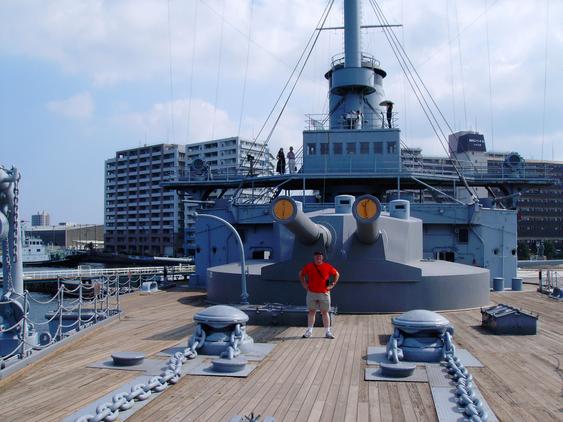
These were replaced with longer ranged 45 caliber weapons, seen above dwarfing the fatass Coastie in the photo.
The secondary guns were 6" in quick firing rifles firing a 100 pound shell. These were not really intended for anti-torpedo boat use, but rather to compensate for the low rate of fire from the 12 inchers (2rds per gun per minute max). It was felt the upperworks could be wrecked by these weapons even if they didn't penetrate armor.
 Additionally,
the short gunnery ranges of the time allowed the fast firing 6 inchers
to be used as spotting weapons for the slow firing 12 inch guns. One
hundred pounds was considered by the UK to be the largest shell that
could be manhandled for a high rate of fire...the Japanese of the era
were considerably smaller than their British counterparts due to both
racial and nutritional factors. Their rate of fire suffered somewhat
and they had to swap off loaders frequently. About 10 years later they
adopted 140mm guns for this reason.
Additionally,
the short gunnery ranges of the time allowed the fast firing 6 inchers
to be used as spotting weapons for the slow firing 12 inch guns. One
hundred pounds was considered by the UK to be the largest shell that
could be manhandled for a high rate of fire...the Japanese of the era
were considerably smaller than their British counterparts due to both
racial and nutritional factors. Their rate of fire suffered somewhat
and they had to swap off loaders frequently. About 10 years later they
adopted 140mm guns for this reason. Interestingly, the gun deck crews slept with their weapons...
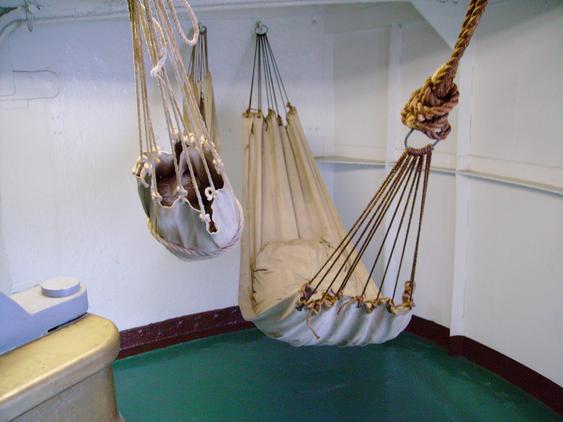 ...just like the sailors of Nelson's day.
...just like the sailors of Nelson's day. The antitorpedo battery consisted of 12 pounders (3 inch guns). They were quite fast firing for their day (20 rpm) and were expected to make short work of any torpedo boats.
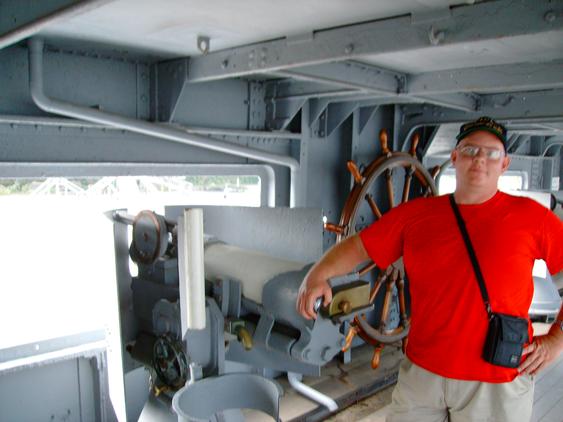 One
of the many lessons learned from this war was that TTB's and their
successors, the Torpedo boat destroyers were a bit more robust than
people thought....and the new torpedoes were nearly equaling the
anti-torpedo boat guns range, thus, larger weapons were needed. Within
a few years, many navies would consider 6" guns necessary for torpedo
defense.
One
of the many lessons learned from this war was that TTB's and their
successors, the Torpedo boat destroyers were a bit more robust than
people thought....and the new torpedoes were nearly equaling the
anti-torpedo boat guns range, thus, larger weapons were needed. Within
a few years, many navies would consider 6" guns necessary for torpedo
defense. 
Note how line was used to provide a forlorn hope of shrapnel protection...



 ...I guess every little bit helps....
...I guess every little bit helps....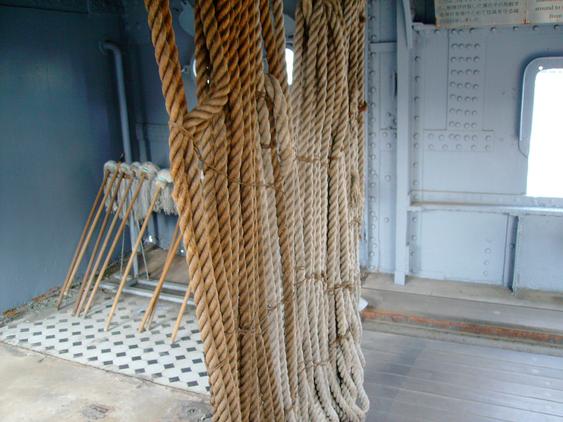
I love it! Here in the heart of ossciffer country...a six-pounder in the conference room!

The ship is every inch a fighter.
The Admirals office. The doors lead to a stern walk, sort of a balcony over the stern....not open to the public at this time.
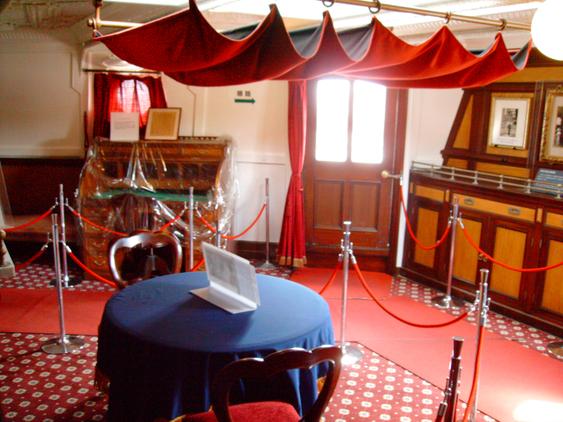
Much of the furniture in this room is not original. It was painstakingly acquired from antique shops in England to match photos of the day. One story* has it that Togo's study was trashed in the late 40s by Soviet diplomats (!?) when they were demanding (in vain) the Mikasa be scrapped.
The pilot house...

...smaller than that on an 87 foot Coast Guard cutter!
Beneath the pilot house is the ships tiny armored conning tower. Measuring only 10 Bobs in circumference on the inside, it was intended to protect the command staff from enemy fire...
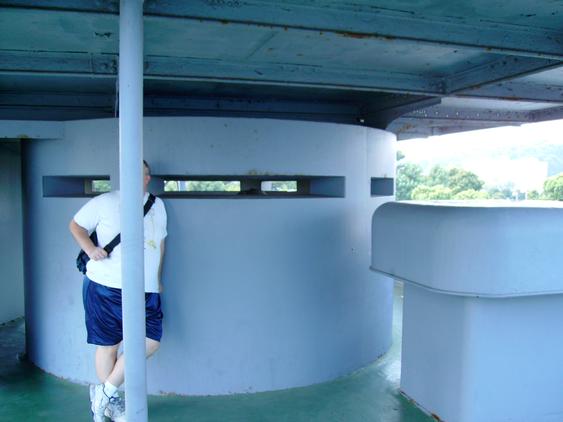

Naturally Admiral Togo was not here during the battle...
He was HERE...(damn loon!)
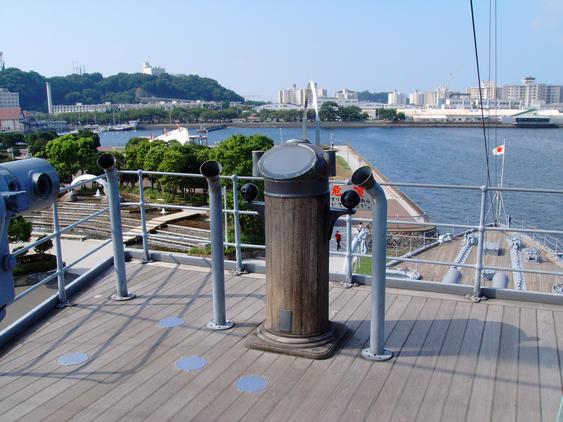
On TOP of the pilot house, note that the Brickmuppet was as far back as possible when taking this pic...that's it! Togo was wounded by shrapnel during the battle of Tsushima, but stayed at his post the whole time taking advantage of the good visibility of his exposed position to direct his fleet.
Battle Damage: This was a searchlight once....
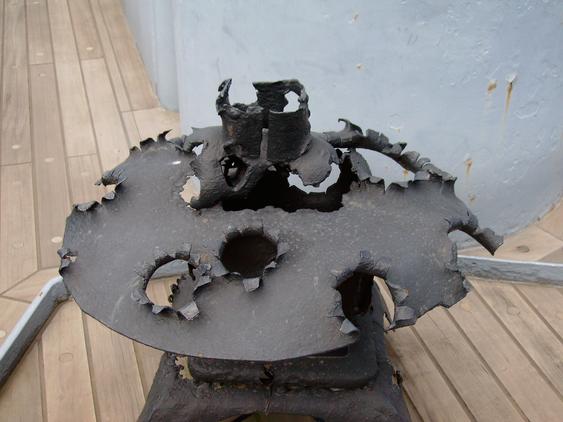
Bob Mitchell points to where the Russians managed to penetrate the casemate armor.

I was surprised to see they were using stereo rangefinders so early....


One Question for naval historians and architects:
Why the insanely complex tackle arrangement for the anchors? Modern Danforth anchors were in use within a decade.
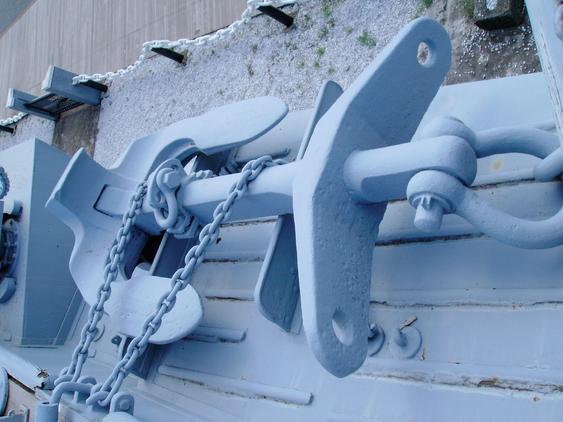 Was there a technical hurdle to the simpler modern anchor arrangements? Or is it, just a case of "simple being hard"?
Was there a technical hurdle to the simpler modern anchor arrangements? Or is it, just a case of "simple being hard"?Finally, Admiral Togo:
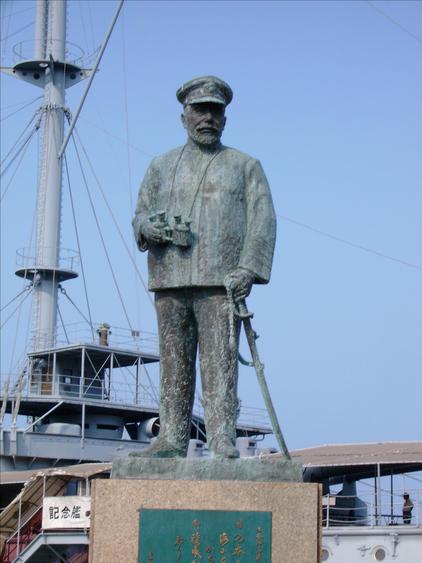
In addition to his Naval accomplishments Wonderduckpoints out that Admiral Togo achieved culinary significance as he helped popularize curry in Japan (he made it a standard dish in the IJN in 190
And Now a word from our sponsors
A local curry restaurant, Yokuska Curry, is, evidentially, a major sponsor of the museum, their ads are in the museum, their curry is on sale at the gift shop and their mascot greets visitors just outside the grounds...
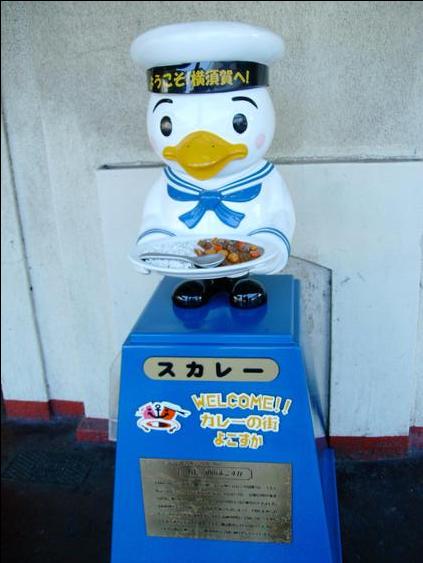
Nothing says good curry and naval history like a duck in a sailor suit...
*NOTE:I can't track down the source on this and the information on site is oddly vague regards WHAT happened to the furniture. Note though, that this peculiar story is not as far fetched as it seems...When the USSR returned some British vessels they had been lent, they had filled the crew spaces and galleys with human feces.
**UPDATE: Pete Zaitcev points out in the comments that the small Russian protected cruiser Avrora did in fact escape. This is particularly ironic because not only did she survive the battle she survives to this day... Aurora fired the opening shots of the Russian Revolution and as such is preserved as a museum ship in St. Petersburg. The text has been corrected. Thanks!
Posted by: The Brickmuppet at
02:07 PM
| Comments (10)
| Add Comment
Post contains 1725 words, total size 15 kb.
Posted by: Pete Zaitcev at Sun Aug 26 14:26:41 2007 (9imyF)
And shortly after this, when the Japanese seemed to be getting too big for their britches, Teddy Roosevelt sent the "Great White Fleet" on its legendary world tour. They visited a lot of places, but Japan was the real destination.
When the Russian fleet finally reached Japanese waters, it was in dreadful shape. The Great White Fleet, on the other hand, was in superb condition. It was larger. It was more modern (mostly).
The visit was entirely cordial, but the message was clear: if it had been the Americans instead of the Russians at Tsushima, the Japanese would have lost.
Posted by: Steven Den Beste at Sun Aug 26 14:59:21 2007 (+rSRq)
I remember visiting the Mikasa back in 1965. She was also used as a set for several scenes involving Adm. Yamamoto in the movie Tora, Tora, Tora.
Wonderduck, in regards to your question about the anchor arrangements. Stockless anchors weren't matched with built-in hawse pips until about 1885. The HMS Formidable (upon which Mikasa and her sisters were based) wasn't launched until 1898. Plans for Formidable probably were drawn up around 1890 or so. At that time, the concept was probably too new for the Royal Navy. Also, the USS Atlanta, a Protected Cruiser of the "new" U.S. Navy was of the same vintage as Formidable and had the same arrangement.
Posted by: 74 at Sun Aug 26 20:43:20 2007 (hznqp)
Um... thanks, 74, but it was Muppet that was wondering that. To be honest, I wasn't even curious... how an anchor is rigged is one of those details that matter only to people who need a ship to go to sea.
Posted by: Wonderduck at Sun Aug 26 21:09:39 2007 (Hrqgp)
Posted by: Stef at Thu Jul 29 21:16:10 2010 (cz9+l)
Posted by: GAMERA at Mon Dec 26 11:51:39 2011 (mKQpI)
That's Sucurry (in English) or Sukare- (in Japanese).
"Suka" borrowed from "Yokosuka" + "kare-" transliterated from "curry".
Sucurry's the mascot character for Yokosuka curry.
The Japanese words on its cap are "Youkoso! Yokosuka he!", literally "Welcome! To Yokosuka".
BTW, it's a gull, not a duck.
Posted by: GAMERA at Mon Dec 26 12:18:50 2011 (mKQpI)
His Imperial Japanese Majesties Ship
His Imperial Japanese Majesty's Ship
Ghaaah!
Actually I've seen both spellings. However a quick look at the dictionary gives:
Majesties=plural
Majesty's=possessive
So I corrected the typo that's been at the top of the post for 4...years. (facepalm)
ã‚ã‚ŠãŒã¨ã”ã„ã¾ã™ã€‚
BTW, it's a gull, not a duck.
That is the single duckiest looking gull I have ever seen.
For the sake of one of our readers we will speak no more of this.
Posted by: The Brickmuppet at Tue Dec 27 01:31:53 2011 (EJaOX)
BTW, I'm more into air forces (bombers and fighters), than navies.
] ã‚ã‚ŠãŒã¨ã”ã„ã¾ã™ã€‚
ã‚ã‚ŠãŒã¨ã†ã”ã–ã„ã¾ã™ã€‚
Arigatou gozaimasu.
Posted by: GAMERA at Wed Dec 28 09:13:54 2011 (mKQpI)
69 queries taking 0.082 seconds, 384 records returned.
Powered by Minx 1.1.6c-pink.









